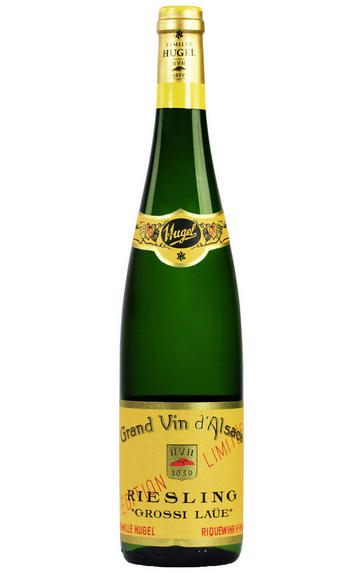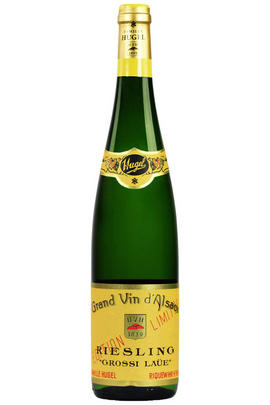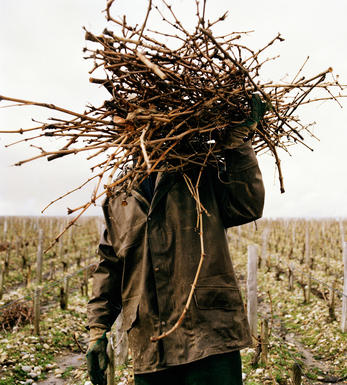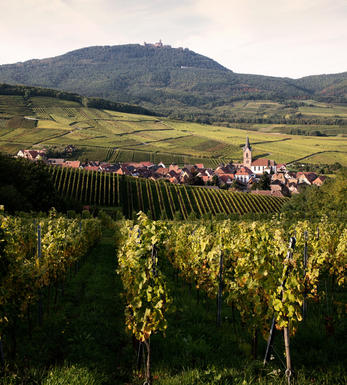
2010 Riesling, Grossi Laüe, Famille Hugel, Alsace

Critics reviews
Stephan Reinhardt - 30/10/2015
About this WINE

Hugel et Fils
Now run by the 13th generation, Hugel is one of the oldest family estates in Alsace. Hugel enjoys a well-earned reputation for its wines at every level, but particularly for its dry Grand Cru Riesling and the sweet late-harvest and botrytised styles.
About the producer
Hugel was founded in Riquewihr in 1639 by Hans Ulrich Hugel. It has remained in the family ever since. The modern era here began in 1902 when Frédéric Emile Hugel moved the business to premises in the centre of the village. He was a true pioneer of Alsace wines, responsible for obtaining official recognition for the late-harvest Vendange Tardive and botrytised Sélection de Grains Nobles wines. The domaine continues to make some of the finest examples of these styles.
The family makes wine using fruit from its own vineyards and from local growers with whom they have long-term contracts. The range includes wines from all the regional varieties, though as with most top Alsatian producers, it is Hugel’s Rieslings which are most highly prized.
In the vineyard
The Hugel family’s vineyards cover more than 25 hectares, exclusively in Riquewihr, almost half of which are classified as Grand Cru. The vineyards, whose average vine age is at least 30 years, are managed organically. Yields are rigorously controlled by trellising methods, canopy management and thinning of excess bunches. Harvest is done by hand, where careful selection also manages yields.
As well as farming their own estate, the family purchase grapes from growers under long-term contract, farming more than 100 hectares. This enables Hugel to use fruit from a dozen of the best villages in the surrounding areas.
In the winery
Grapes are inspected and sorted on arrival to the winery, and presses are filled by gravity. Both stainless-steel tanks and oak foudres are used for maturation, varying depending on the grape variety and quality level.
Hugel divide their extensive range into four levels: Famille Hugel Classics, made from purchased fruit; Famille Hugel Estate, made exclusively from estate-grown grapes; Hugel Tradition and Famille Hugel Grossi Laüe (formerly Hugel Jubilee), both using a combination of purchased and estate grapes, from the most favoured sites in the portfolio.
The range also includes separate categories for their Vendange Tardive and Sélection de Grains Nobles wines, Gentil (a blend of regional varieties) and a wine from Grand Cru Schoenenbourg called Riesling Schoelhammer, launched in 2007.

Riesling AOC Alsace
Riesling is the undisputed king of Alsace grapes, covering 22.5 percent of the vineyard area and producing some of the noblest and most age-worthy wines in the region, including Vendange Tardive, Sélection de Grains Nobles, and Grands Crus.
Dry, refined, and delicately fruity, it has an elegant bouquet of citrus fruit with mineral or floral notes. A typical mature Alsace Riesling is bone dry, with steely acidity and complex mineral and flint aromas. Like its German counterpart, it displays a superb definition of flavours, but with more concentration and alcohol.
It thrives on schist, shale and slate soils that convey oily, petrolly, mineral aromas to the wine.

Riesling
Riesling's twin peaks are its intense perfume and its piercing crisp acidity which it manages to retain even at high ripeness levels.
In Germany, Riesling constitutes around 20% of total plantings, yet it is responsible for all its greatest wines. It is planted widely on well-drained, south-facing slate-rich slopes, with the greatest wines coming from the best slopes in the best villages. It produces delicate, racy, nervy and stylish wines that cover a wide spectrum of flavours from steely and bone dry with beautifully scented fruits of apples,apricots, and sometimes peaches, through to the exotically sweet flavours of the great sweet wines.
It is also an important variety in Alsace where it produces slightly earthier, weightier and fuller wines than in Germany. The dry Rieslings can be austere and steely with hints of honey while the Vendages Tardives and Sélection de Grains Nobles are some of the greatest sweet wines in the world.
It is thanks to the New World that Riesling is enjoying a marked renaissance. In Australia the grape has developed a formidable reputation, delivering lime-sherbet fireworks amid the continental climate of Clare Valley an hour's drive north of Adelaide, while Barossa's Eden Valley is cooler still, producing restrained stony lime examples from the elevated granitic landscape; Tasmania is fast becoming their third Riesling mine, combining cool temperatures with high UV levels to deliver stunning prototypes.
New Zealand shares a similar climate, with Riesling and Pinot Gris neck to neck in their bid to be the next big thing after Sauvignon Blanc; perfectly suited is the South Island's Central Otago, with its granitic soils and continental climate, and the pebbly Brightwater area near Nelson. While Australia's Rieslings tend to be full-bodied & dry, the Kiwis are more inclined to be lighter bodied, more ethereal and sometimes off-dry; Alsace plays Mosel if you like.


Buying options
Add to wishlist
Description
The first ever offering of this wine, with it previously being known as the Jubilee Riesling. They have taken the opportunity the change in name has given to dial this up more than a notch or two, this is one of the best defined and purest Riesling that I have tried for some considerable time.
It is clearly on a par with Frederick Emile from the Trimbach Estate (my previous benchmark wine) and its amazing pure expression is a wonderful thing. Crystalline fruit and a lovely touch of peach combines with classic Riesling petrol notes. This is 5 years old and yet tastes as though it was made yesterday, with this in mind I am predicting a long and glorious future, certainly 15 years and possibly 20 years for this beauty of a wine.
Matthew Tipping, Fine Wine Sales Manager
For most professionals, let alone consumers, Alsace is complicated, alongside the plethora of producers, some bad, some good, it is often hard to decipher the quality of the vineyard let alone the producer all at the same time as trying to understand the dryness or sweetness of a given wine.
With the customer in mind, Hugel have redesigned their range to reflect the different levels of quality in very simple and International terms.
Hugel first and foremost is an advocate of the dry style of Alsace wine. Hugel wines are tight, structured, mineral and dry – unless they’re sweet.
The “Grossi Laüe" range is made from their top Grand Crus vineyards (Riesling from the Schoenenbourg and Gewurztraminer from the Sporen).
Finally, the crème de la crème “Schoelhammer” which is on par with the great Trimbach Clos St Hune. The tiny production of this single vineyard called “Schoelhammer” is proudly sitting at the top of the their range, made from only 30 rows of vines and with a mere 4288 bottle production.
wine at a glance
Delivery and quality guarantee